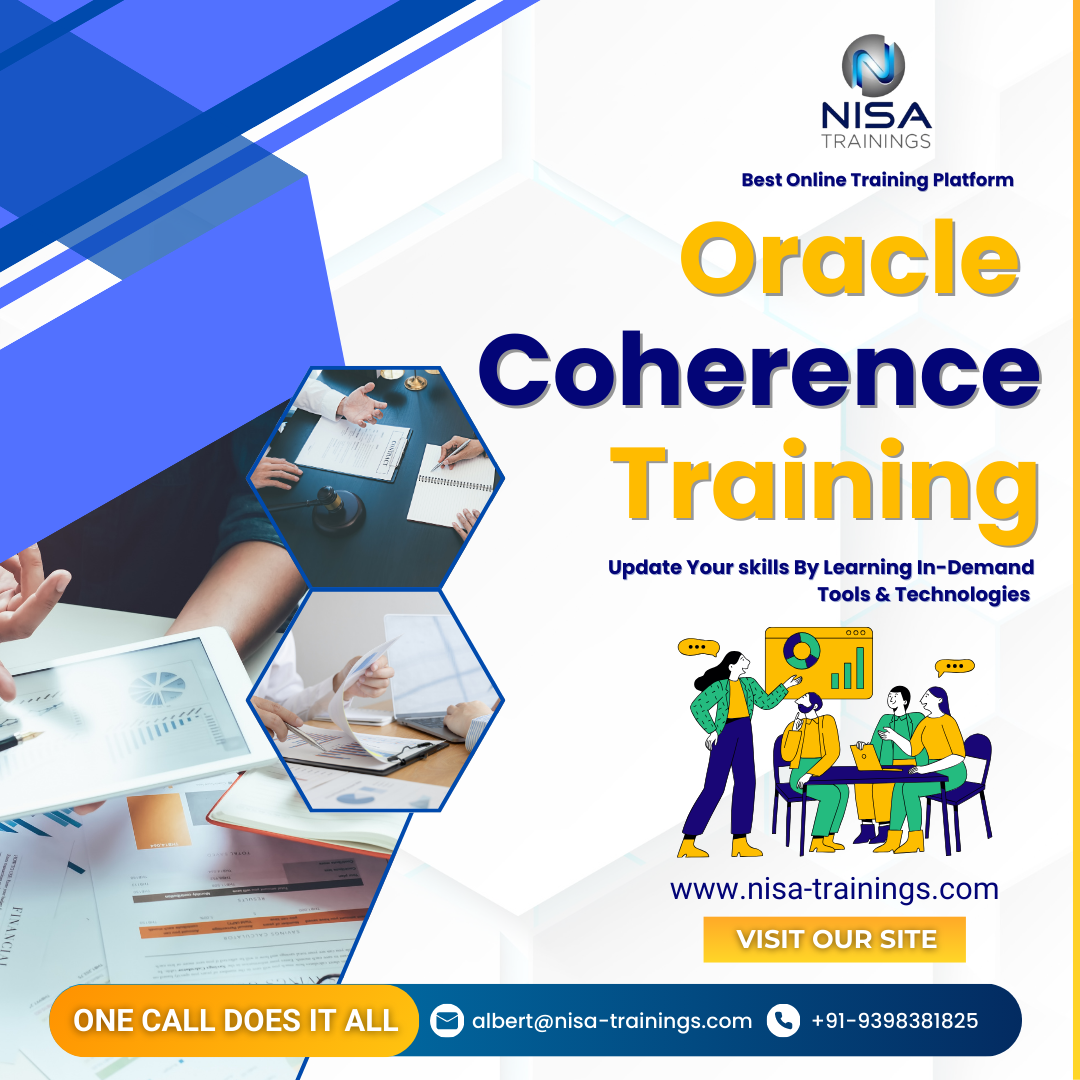Oracle Coherence Training
Oracle Coherence is an in-memory data grid (IMDG) solution that allows organizations to scale their applications by distributing data and computation across multiple nodes in a cluster. It is designed for high-performance, low-latency applications that require quick access to data stored in-memory.

Why should you choose Nisa For Oracle Coherence Training?
Nisa Trainings is the best online training platform for conducting one-on-one interactive live sessions with a 1:1 student-teacher ratio. You can gain hands-on experience by working on near-real-time projects under the guidance of our experienced faculty. We support you even after the completion of the course and happy to clarify your doubts anytime. Our teaching style at Nisa Trainings is entirely hands-on. You’ll have access to our desktop screen and will be actively conducting hands-on labs on your desktop.
Job Assistance
If you face any problem while working on Oracle Coherence Course, then Nisa Trainings is simply a Call/Text/Email away to assist you. We offer Online Job Support for professionals to assist them and to solve their problems in real-time.
The Process we follow for our Online Job Support Service:
- We receive your inquiry for Online Job
- We will arrange a telephone call with our consultant to grasp your complete requirement and the tools you’re
- If our consultant is 100% confident in taking up your requirement and when you are also comfortable with our consultant, we will only agree to provide service. And then you have to make the payment to get the service from
- We will fix the timing for Online Job Support as mutually agreed by you and our consultant.
Course Information
Oracle Coherence Training
Duration: 25 Hours
Timings: Weekdays (1-2 Hours per day) [OR] Weekends (2-3 Hours per day)
Training Method: Instructor Led Online One-on-One Live Interactive
Sessions.
COURSE CONTENT :
1. Introduction to Oracle Coherence
- What is Oracle Coherence?
- Overview of in-memory data grid (IMDG) and distributed caching.
- Use cases in real-time, high-performance systems.
- Benefits of using Coherence (scalability, low-latency, high availability).
- Coherence Architecture
- Clusters, nodes, and partitioned data.
- Distributed caches and the role of cache servers.
- Introduction to Coherence cluster design.
- Coherence Data Models
- Replicated caches vs. partitioned caches.
- Cache topology (partitioning, sharding, and replication).
2. Coherence Basic Concepts
- Cache Basics
- Definition and purpose of a cache.
- How data is distributed and cached across nodes.
- Cache eviction strategies (LRU, Least Frequently Used, etc.).
- Cache Types
- Partitioned Cache: Benefits and use cases.
- Replicated Cache: Benefits and use cases.
- Working with Coherence
- Creating and configuring a simple Coherence cache.
- Using Coherence with standard Java collections and POJOs (Plain Old Java Objects).
- Inserting and Retrieving Data
- Adding, updating, and removing entries from the cache.
- Basic cache operations:
put(),get(),remove().
3. Data Structures & Advanced Caching
- Coherence Data Structures
- EntryProcessor, CacheMap, CacheList, CacheSet.
- Distributed data structures: Maps, Sets, Lists.
- Coherence Query Language (CQL)
- Introduction to querying distributed caches.
- Filtering and retrieving data from Coherence using CQL.
- Eviction Policies and Expiration
- Time-based expiration vs. space-based eviction.
- Managing cache lifecycle with eviction strategies.
4. Coherence for Distributed Computing
- MapReduce and Distributed Processing
- Understanding distributed computation with Coherence.
- Using Coherence to implement MapReduce tasks.
- Parallel execution with Coherence.
- Events and Listeners
- Event-driven programming with Coherence.
- Implementing listeners for cache events (insert, update, remove).
- Subscription and processing of events.
5. Coherence Advanced Features
- Coherence*Extend
- Extending a Coherence grid to remote clients (Coherence*Extend).
- Integration of Coherence with WebLogic Server, JMS, etc.
- Coherence and JCache (JSR-107)
- Introduction to JCache API.
- Integration with Coherence for unified caching solutions.
- Distributed Transactions
- Implementing distributed transactions with Coherence.
- Consistency models and CAP theorem (availability, consistency, partition tolerance).
6. Performance Optimization and Scalability
- Performance Tuning
- Optimizing cache access and data retrieval.
- Adjusting partitioning strategies for better performance.
- Garbage collection and heap management in Coherence.
- High Availability and Fault Tolerance
- Configuring replication and backup strategies.
- Ensuring data availability during node failure.
- Failover mechanisms and disaster recovery with Coherence.
- Scaling Coherence
- Horizontal scaling with Coherence clusters.
- Dynamic scaling with automatic partition redistribution.
- Handling network latencies and balancing across nodes.
7. Coherence Security
- Security Basics
- Authentication and authorization with Coherence.
- Securing communications in the cluster.
- Implementing security policies at the cache and cluster level.
8. Coherence Integration with Other Systems
- Integration with Java EE / Spring Framework
- Using Coherence with Java EE applications.
- Spring Cache integration with Oracle Coherence.
- Coherence and Oracle Database
- Using Coherence as a caching layer with Oracle Database.
- Configuring Coherence for database integration.
- Coherence on Cloud
- Coherence integration with Oracle Cloud Infrastructure (OCI).
- Deploying Coherence on Kubernetes or Docker for scalable applications.
9. Coherence Administration and Monitoring
- Coherence Management
- Using Coherence’s administrative tools for cluster management.
- Coherence web console for real-time monitoring.
- Configuring the Coherence logs for diagnostics.
- Monitoring and Troubleshooting
- Monitoring cache usage, memory consumption, and system health.
- Using tools like JMX for performance diagnostics.
- Upgrading and Maintenance
- Strategies for updating Coherence without downtime.
- Managing distributed system upgrades.
10. Real-World Coherence Use Cases
- Coherence in E-Commerce and Financial Services
- Real-time analytics and fraud detection.
- Session management for high-traffic applications.
- Coherence in IoT and Real-Time Systems
- Streamlining real-time data processing for IoT devices.
- Real-time dashboard updates using Coherence.
